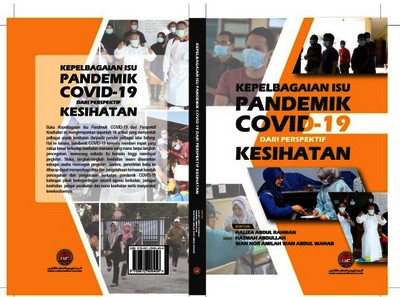Haris @ Harith, Muhammad Salahuddin (2021) Keselamatan dan Keberkesanan Ubat-ubatan dalam Merawat Pesakit COVID-19 di Malaysia dan Indonesia. In: Kepelbagaian Isu Pandemik Covid-19 Dari Perspektif Kesihatan. UPSI Press, pp. 181-209.
|
PDF (Chapter in Research Book)
- Published Version
Restricted to Registered users only Download (627kB) | Request a copy |
||
![[img]](http://irep.iium.edu.my/88861/2.hassmallThumbnailVersion/Cover%20Page.jpeg)
|
PDF
Download (111kB) | Preview |
|
![[img]](http://irep.iium.edu.my/88861/3.hassmallThumbnailVersion/Penerbit.jpeg)
|
PDF
Download (104kB) | Preview |
|
|
PDF
Download (71kB) | Preview |
|
![[img]](http://irep.iium.edu.my/88861/5.hassmallThumbnailVersion/ISBN.jpeg)
|
PDF
Download (132kB) | Preview |
|
|
PDF
- Published Version
Restricted to Repository staff only Download (1MB) | Request a copy |
Abstract
PENGENALAN Dunia berhadapan dengan pandemik global setelah merebaknya penyakit novel koronavirus 2019 (COVID-19). Pandemik COVID-19 ini menyebabkan sindrom pernafasan akut yang teruk dan boleh membawa kepada kematian (Zhai et al. 2020). Sejak Disember 2019 sehingga 18 Mei 2020, Pertubuhan Kesihatan Sedunia (WHO) melaporkan terdapat lebih daripada 4,600,000 kes positif dan 312,009 kes kematian melibatkan lebih daripada 200 buah negara (World Health Organization, 2020a). Setakat 18 Mei 2020, Malaysia mencatatkan 6,941 kes positif dan 113 kes kematian iaitu bersamaan dengan 1.63%. Di Indonesia pula, sejumlah 18,010 kes positif dan 1,191 kes kematian dilaporkan dengan kadar kematian 6.61% (Outbreak.my, 2020). Berdasarkan padanan genetik, novel koronavirus atau sindrom respiratori akut teruk-koronavirus-2 (SARS-CoV-2) ialah virus daripada keluarga koronavirus yang serupa dengan sindrom respiratori akut teruk-koronavirus (SARS-CoV) dan sindrom pernafasan timur tengah-koronavirus (MERSCoV) (Zhou et al. 2020). SARS-CoV-2 ialah virus yang mengandungi RNA yang diselaputi oleh protein envelop. Di bahagian luar protein envelop ini terdapat tiara protein yang dikenali sebagai S protein. Daripada tiara protein inilah, virus ini mendapat namanya sebagai koronavirus. S protein ini amat penting bagi koronavirus kerana protein ini membolehkan koronavirus melekat kepada Angiotensin Converting Enzyme-2 (ACE-2) reseptor yang terdapat pada bahagian luar sel (Sanders et al. 2020). Apabila novel koronavirus ini melekat pada ACE-2 reseptor, sel membenarkan virus ini untuk masuk ke dalam secara endositosis. Virus ini kemudian menjadikan sel sebagai tempat untuk membiak dan menghasilkan lebih banyak virus. Apoptosis dan kematian sel berlaku dan merembeskan virus ini untuk menyerang sel-sel badan yang lain (Gurwitz, 2020) the coronavirus COVID-19 epidemic has already resulted in more fatalities compared with the SARS and MERS coronavirus epidemics combined. Therapeutics that may assist to contain its rapid spread and reduce its high mortality rates are urgently needed. Developing vaccines against the SARS-CoV-2 virus may take many months. Moreover, vaccines based on viral-encoded peptides may not be effective against future coronavirus epidemics, as virus mutations could make them futile. Indeed, new Influenza virus strains emerge every year, requiring new immunizations. A tentative suggestion based on existing therapeutics, which would likely be resistant to new coronavirus mutations, is to use available angiotensin receptor 1 (AT1R).
| Item Type: | Book Chapter |
|---|---|
| Additional Information: | 88861/6657 |
| Subjects: | R Medicine > RS Pharmacy and materia medica |
| Kulliyyahs/Centres/Divisions/Institutes (Can select more than one option. Press CONTROL button): | Kulliyyah of Pharmacy |
| Depositing User: | Dr. Muhammad Salahuddin Haris |
| Date Deposited: | 18 Mar 2021 12:26 |
| Last Modified: | 03 Jun 2021 15:11 |
| URI: | http://irep.iium.edu.my/id/eprint/88861 |
Actions (login required)
 |
View Item |




 Download Statistics
Download Statistics Download Statistics
Download Statistics